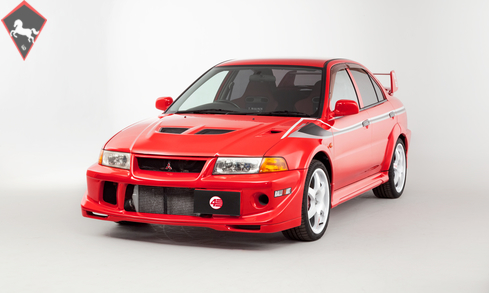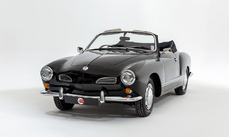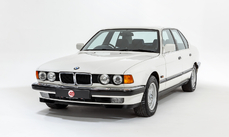Mitsubishi Lancer VI Tommi Makinen 2000
Allgemeine Beschreibung :
Model History
The Lancer Evolution was a high-performance sports car based on the standard Mitsubishi Lancer. There have been ten official versions to date, and the designation of each model is most commonly a Roman numeral. All use two-litre, turbocharged engines and all-wheel drive systems.
The Evolution was originally intended only for Japanese markets, but demand on the "grey import" market led the Evolution series to be offered through Ralliart dealer networks in the United Kingdom and in various European markets from around 1998. Japanese-spec cars were limited by a gentlemen's agreement to advertise no more than 276hp, a mark already reached by Evolution IV. Therefore, each subsequent version has unofficially evolved above the advertised power figures, with the Japanese-spec Evolution IX reaching an alleged output of around 317hp.
The Evo VI was produced from January 1999 until March 2001. The improvements over its predecessor mainly focused on cooling and engine durability. It received a larger intercooler, larger oil cooler, and new pistons. The Evolution VI received new bodywork yet again, with the most easily noticeable change being within the front bumper where the huge fog lights were reduced in size and moved to the corners for better airflow.
Great rally success was achieved in the WRC Rallies from 1996-1999 thanks to the legendry Finn Tommi Makinen for clinching the drivers titles in this period and help from team mate Richard Burns for clinching the constructors championship for the first, and thus far only time in 1998.
In 1999 the Tommi Makinen Edition was released. It featured a different front bumper, red and black Recaro seats embossed with the Tommi Makinen logo, 17-inch white Enkei wheels, a red-stitched leather Momo steering wheel and shift knob, a titanium turbine that spooled up more quickly, front upper strut brace, lowered ride height (with tarmac stages in mind), and a quicker steering ratio, among other things. The car is sometimes referred to as an Evolution 6.5, or TME for short.
The Tommi Makinen Edition was only available in Scotia White, Satellite Silver, Pyrenees Black, Canal Blue, and Passion Red (the only colour scheme available with the Works stripes and decals kit). Out of all the colours, the red is considered to be most collectable; certainly the used car market favours it as values are seen to be increasing year on year. In total there were 2,021 GSR and just 678 RS lightweight variants. It is believed that only 212 cars were produced in red with the Special Colour Pack.
Equipment
Special Colour Pack, TME embroidered Recaro front seats, 18-inch Compomotive MO1882 alloy wheels, Front and side airdams, Twin-wing rear spoiler with high-mount stop lamp, Specially tuned suspension, Brembo brakes, Electric-folding door mirrors, Digital climate control AC, Electric windows, Power steering, Momo leather steering wheel with red stitching, Leather gear knob and gaiter with red stitching, Front airbags, Remote central locking, Radio delete, Kakimoto Racing stainless exhaust, Mitsubishi wind deflectors, Privacy glass, Spare wheel.
Exterior
The gleaming Passion Red paintwork looks superb alongside the Works stripes and decals. Visually similar to the Championship winning cars made famous by rally legend Tommi Makinen, it comes as no surprise that Special Colour Pack TMEs like this one have fast become the most sought after of all. Amazingly there is no fading or damage to the bodywork and almost no stone chips to the front end. None of the trims or rubbers have ever been sun-damaged and the decals present extremely well all round.
Interior
The specially-embroidered TME Recaro seats present really well and show few signs of use; the velour bolsters are usually the first areas to wear but these remain in excellent order with no rips or bobbling to report. The dash and centre console are also free from any significant marks and pleasingly there are no aftermarket gauges or controllers fitted. Commonly worn items such as the steering wheel and gear knob are in good original condition, not entirely unworn but perfectly in line with the mileage.
ENGINE & TRANSMISSION
The turbocharged 2-litre rockets the Evo from 0-60 mph in little over 4 seconds. The five-speed manual gearbox still feels tight, and the all-wheel-drive system provides enough confidence to power though corners at speed. Despite its high-performance credentials, the Evo VI still drives with typical Japanese-car ease; operating smoothly at low speeds before launching into ferocious acceleration at anything above 4000 rpm.
The engine bay of this example is remarkably original with absolutely no modifications or aftermarket components fitted; even the factory blow-off valve is still in place. The car presents in excellent mechanical fettle having received a full service, cambelt change, and new clutch at Mitsubishi around 200 miles ago. Sold with a fresh 12 month MOT.
WHEELS, TYRES & BRAKES
The Evo sits on stunning six-spoke Compomotive alloys, all in perfect unmarked condition having seen little use since fitting. They are shod in matching Goodyear rubber with at least 6mm of tread remaining at each corner. Out on the road the Brembo brakes perform effortlessly, stopping the car quickly and in a straight line.
History File
This rare Special Colour Pack Tommi Makinen was first registered in February 2000. It was supplied new in Japan, remaining there until late 2016 when it was imported by 4 Star. It has been carefully stored with us ever since and is now offered for sale for the first time in the UK, fully registered and with 12 months MOT upon sale.
The paperwork is complete with Japanese service history, original owner’s manuals, UK registration documents, and Mitsubishi invoices for the recent cambelt service and clutch replacement; the work was carried out by Farnham Mitsubishi little over 200 miles ago at a cost of over £2,800.
http://www.4starclassics.com/for-sale/mitsubishi-evo-vi-tommi-makinen-for-sale/
2000 Mitsubishi Lancer VI Tommi Makinen is listed verkauft on ClassicDigest in Kingsley by 4 Star Classics for £39995.
Fakten der Auto
Karosserietyp : Auto Marke : Mitsubishi Modell : Lancer Ausführung : VI Tommi Makinen Hubraum : 2.0 Modelljahr : 2000 Karosstyp : Pick up Lage : Hampshire
Verkauft
Angaben Zum Verkäufer
Verkauft
People who viewed this Mitsubishi Lancer also viewed similar Mitsubishi listed at ClassicDigest
Other cars listed for sale by this dealer
über Mitsubishi
Mitsubishi: Eine Reise durch die Geschichte (bis in die 1980er Jahre)1. Frühe Anfänge:
Gründung: Mitsubishis Wurzeln reichen zurück zur Gründung einer Schifffahrtsfirma durch Yataro Iwasaki im Jahr 1870.
Diversifizierung: Das Unternehmen expandierte in den Bergbau, den Schiffbau und andere Branchen, was die Grundlage für die Mitsubishi Group bildete.
2. Erste Automobilunternehmungen:
Erste Automobilproduktion: Mitsubishi wagte sich im frühen 20. Jahrhundert in die Automobilproduktion.
Modell-A: Im Jahr 1917 führte Mitsubishi sein erstes Serienfahrzeug, das Modell-A, ein, Japans erstes Serienautomobil.
3. Nachkriegsära:
Umstrukturierung: Nach dem Zweiten Weltkrieg stand Mitsubishi vor Herausforderungen, durchlief jedoch eine Umstrukturierung und nahm die Automobilproduktion wieder auf.
Produktion von Jeeps: Anfangs konzentrierte sich Mitsubishi auf die Produktion von Jeeps und trug erheblich zur Wiederbelebung der japanischen Automobilindustrie bei.
4. Meilenstein-Modelle:
Mitsubishi 500: 1960 eingeführt, war der Mitsubishi 500 ein Kompaktfahrzeug, das dazu beitrug, kleinere Fahrzeuge in Japan populär zu machen.
Mitsubishi Colt 600: 1962 herausgebracht, war der Colt 600 ein Kleinwagen, der dazu beitrug, Mitsubishis Präsenz auf dem Automobilmarkt zu stärken.
5. Globale Expansion und die 1970er Jahre:
Partnerschaften: Mitsubishi schloss Partnerschaften mit internationalen Automobilherstellern und erweiterte damit seinen Einfluss über Japan hinaus.
Galant und Lancer: Modelle wie der Galant und der Lancer gewannen in den 1970er Jahren an Popularität und zeigten Mitsubishis Engagement für Innovation und Leistung.
6. Technologische Fortschritte:
Mitsubishi Astron-Motor: In den 1970er Jahren eingeführt, wurde der Astron-Motor zum Markenzeichen von Mitsubishi-Fahrzeugen und war bekannt für seine Langlebigkeit und Effizienz.
7. Höhepunkt der 1980er Jahre:
Mitsubishi Pajero: Anfang der 1980er Jahre eingeführt, markierte der Pajero (Montero in einigen Märkten) Mitsubishis Einstieg in das SUV-Segment und wurde ein globaler Erfolg.
Starion: Der Starion, Mitte der 1980er Jahre eingeführt, war ein Sportwagen, der Mitsubishis Leistungsfähigkeit demonstrierte.
8. Klassische Modelle von Mitsubishi der 1980er Jahre:
Mitsubishi Delica: Der Delica, erstmals in den 1960er Jahren eingeführt, gewann in den 1980er Jahren an Popularität und war ein vielseitiger Van in verschiedenen Konfigurationen.
Mitsubishi Mighty Max: Dieser kompakte Pickup-Truck war bekannt für seine Robustheit und Praktikabilität.
Mitsubishi Mirage: Der Mirage, in Hatchback- und Limousinen-Versionen erhältlich, wurde aufgrund seiner Kraftstoffeffizienz und Zuverlässigkeit beliebt.
Mitsubishis Reise durch die 1980er Jahre spiegelt ihre Entwicklung von einem vielfältigen Konglomerat zu einem bedeutenden Akteur in der globalen Automobilindustrie wider. Das Jahrzehnt brachte die Einführung von ikonischen Modellen mit sich, die Mitsubishis Ruf für Innovation und Leistung stärkten.







